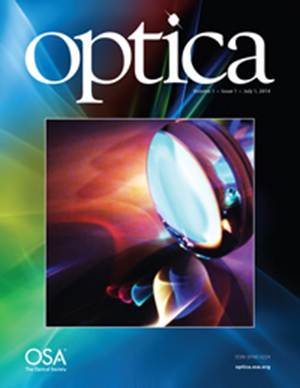Computational imaging with meta-optics
IF 8.5
1区 物理与天体物理
Q1 OPTICS
引用次数: 0
Abstract
Sub-wavelength diffractive meta-optics have emerged as a versatile platform to manipulate light fields at will, due to their ultra-small form factor and flexible multifunctionalities. However, miniaturization and multimodality are typically compromised by a reduction in imaging performance; thus, meta-optics often yield lower resolution and stronger aberration compared to traditional refractive optics. Concurrently, computational approaches have become popular to improve the image quality of traditional cameras and exceed limitations posed by refractive lenses. This in turn often comes at the expense of higher power and latency, and such systems are typically limited by the availability of certain refractive optics. Limitations in both fields have thus sparked cross-disciplinary efforts to not only overcome these roadblocks but also to go beyond and provide synergistic meta-optical–digital solutions that surpass the potential of the individual components. For instance, an application-specific meta-optical frontend can preprocess the light field of a scene and focus it onto the sensor with a desired encoding, which can either ease the computational load on the digital backend or can intentionally alleviate certain meta-optical aberrations. In this review, we introduce the fundamentals, summarize the development of meta-optical computational imaging, focus on latest advancements that redefine the current state of the art, and give a perspective on research directions that leverage the full potential of sub-wavelength photonic platforms in imaging and sensing applications. The current advancement of meta-optics and recent investments by foundries and technology partners have the potential to provide synergistic future solutions for highly efficient, compact, and low-power imaging systems.元光学计算成像
亚波长衍射元光学由于其超小的外形和灵活的多功能,已经成为一种可以随意操纵光场的多功能平台。然而,小型化和多模态通常会受到成像性能降低的影响;因此,与传统的折射光学相比,元光学通常产生更低的分辨率和更强的像差。同时,计算方法已成为流行,以提高传统相机的图像质量,并超越了折射透镜的限制。这反过来往往以更高的功率和延迟为代价,而且这种系统通常受到某些折射光学器件的可用性的限制。因此,这两个领域的局限性激发了跨学科的努力,不仅要克服这些障碍,还要超越并提供超越单个组件潜力的协同元光学数字解决方案。例如,特定应用的元光学前端可以预处理场景的光场,并将其聚焦到具有所需编码的传感器上,这既可以减轻数字后端的计算负荷,也可以故意减轻某些元光学像差。在这篇综述中,我们介绍了基本原理,总结了元光学计算成像的发展,重点介绍了重新定义当前艺术状态的最新进展,并对利用亚波长光子平台在成像和传感应用中的全部潜力的研究方向进行了展望。当前元光学技术的进步以及代工厂和技术合作伙伴最近的投资有可能为高效、紧凑和低功耗成像系统提供协同的未来解决方案。
本文章由计算机程序翻译,如有差异,请以英文原文为准。
求助全文
约1分钟内获得全文
求助全文
来源期刊

Optica
OPTICS-
CiteScore
19.70
自引率
2.90%
发文量
191
审稿时长
2 months
期刊介绍:
Optica is an open access, online-only journal published monthly by Optica Publishing Group. It is dedicated to the rapid dissemination of high-impact peer-reviewed research in the field of optics and photonics. The journal provides a forum for theoretical or experimental, fundamental or applied research to be swiftly accessed by the international community. Optica is abstracted and indexed in Chemical Abstracts Service, Current Contents/Physical, Chemical & Earth Sciences, and Science Citation Index Expanded.
 求助内容:
求助内容: 应助结果提醒方式:
应助结果提醒方式:


